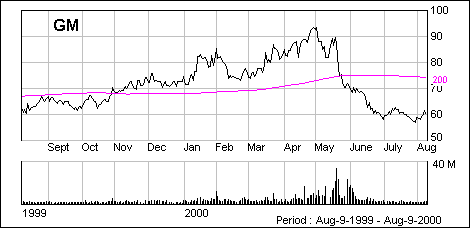GE/GM Indicator Signals Trouble Ahead
As stock market indicators go, nothing beats an up-close examination of the market itself, especially the stocks of leading "blue chip" companies. Two such large-cap, highly traded companies on the New York Stock Exchange are the stocks of major U.S. corporations General Electric (GE) and General Motors (GM). Both stocks, in fact, are considered by many leading market technicians and financial analysts as leading indicators in and of themselves.
For instance, it has been said of General Motors that "what's good for GM is good for America." Under this premise, when the stock of GM is trading well and making new highs, it reflect bullish enthusiasm among inside traders and others "in the know." Such traders know what lies ahead on America's economic path well before the "dumb money" general public. When GM's share price is declining, it reflects bearish sentiment among the "smart money" insiders, who know that economic recession looms over the horizon. This is because whatever changes are felt in the economy are first registered in GM's stock price, since General Motors is a company whose operations are extremely sensitive to interest rate changes, oil price fluctuations, and other general consumer confidence and purchasing power gauges.
The rule of thumb for the GM indicator is that whenever GM's stock price fails to make a new high within any given four month period, it harbingers economic recession for the U.S. As of this writing (July 2000), GM's stock price is more than three months into a sharp decline from its all-time high share price of $94/share (it presently lies at around $60/share). For a historically stable blue-chip like GM to fall so precipitously from an all-time high and languish these many months at or near its low is extremely uncharacteristic. It seems quite clear that GM's price action is signaling trouble on the horizon in the form of economic recession. Unless GM can mount a meaningful rally to new highs by the end of August, the U.S. economic outlook—and by extension the equities market outlook—becomes increasingly dim.

The stock price for General Electric is perhaps in many ways an even more comprehensive economic indicator than that of GM's share price. This is because GE represents four industrial sectors in one: electric utility, communications, capital and financing, and transportation. Through its subsidiary, GE Capital, General Electric controls the largest fleet of railcars in the world. It also provides liquidity to individuals and financial institutions, electricity to power America's electrical grids, and communications for much of the world's population. In many ways, GE suffuses life into the U.S. and world economies, and anything which threatens the financial viability and outlook for GE is a threat to the U.S. economy.

While GE's stock chart is not quite in the bearish position GM's stock is presently in, it is nevertheless showing certain undeniable signs of being under distribution. After an extremely high-volume trading session shortly after making a new all-time high earlier this year, GE's stock has been fluctuating in a lateral trading range on highly variable volume. Even more ominous is the fact that its stock was split 2-for-1 shortly before the high-volume trading spike seen early in the year. This typically precedes major sell-offs by insiders, especially since a stock split at high levels is a form of distribution in an of itself. On Friday, July 28, GE against saw very high trading volume while its share price closed below its previous day's closing price and on the lower part of the day's trading range. This growing sense of bearish urgency to sell GE is further proof that the summer of 2000 is serving as a timeframe of concentrated dumping of GE's shares by insiders in preparation for a major stock market crash later this fall.
Both of these reliable market indicators are flashing clear and unmistakable warnings: prepare for the coming equities market crash! The month of August, which will likely prove to be the last truly bullish month of this year, should be used to recoup earlier losses and to sell into the remaining strength in preparation for the downturn this fall. Cover should be taken in cash and precious metals.

















